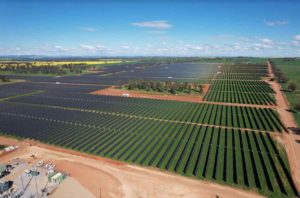The health, economic and political systems of countries around the world have been exposed as being woefully unprepared for the current crisis.
How could they not have been, you may ask? After all, it is a novel virus.
But we have been here before, several times in recent decades: SARS in 2002-2004; the 2009 swine flu; several Ebola outbreaks; and of course HIV AIDS. Arguably it was just a matter of time before one of these evil genii escaped the bottle and went global.
Is there a lesson here for the energy sector? Beyond the need to respond to the current crisis, is there anything to learn about anticipating and preparing for apparently unforeseeable events?
Australia’s energy system had a coronavirus moment with the recent bushfire crisis. It exposed the shortcomings of a system designed for the 20th century when faced with the new reality of more frequent and intense and prolonged severe weather events related to accelerating climate change impacts.
Again, while the scale and ferocity of the bushfire crisis shocked us all, it was bound to happen sooner or later. We had been warned. Yet we are forced to play catch up and react to the devastation after the fact, taking steps to ensure that the next similar crisis does not have similar catastrophic consequences.
What about crises that we have not foreseen, though – the ones that are truly unforeseeable? It is critical that we learn to think and act in ways that that allow us to be better prepared for unknowns.
In December last year Energy Consumers Australia (ECA) convened a scenario planning workshop with a group of consumer advocates to generate consumer-focused future contexts for the supply of heat, light, and power in Australia.
It was convened by Dr Matt Finch from Oxford University’s Saïd Business School, and the reworked outcomes were featured at the ECA Foresighting Forum in February.
As Matt Finch explains in his report for ECA, the scenarios in this document represent four distinct visions for the future of energy in Australia, looking ahead to 2050. They are not predictions, but contexts crafted to highlight issues which challenge our current strategic thinking.
The scenarios have been selected to emphasise the changing role of the consumer, and the ways in which economic or social shifts might impact the way energy is generated, supplied, and consumed.
Here is a brief summary of the four scenarios:
- Bundle: What happens if consumers’ heat, light, and power needs get bundled with employment or other services?
- Patchwork: Could declining trust see the national energy grid fragment, requiring local action?
- Plenty: What if catastrophic climate change frees us to generate abundant wind and solar power?
- Rescue: What if a new movement drives transition to cheap renewable energy whilst compensating incumbents?
It would be easy to quibble with the final scenarios, and during the December workshop I found it frustrating that we were forced to entertain highly implausible futures, such as a benign Chinese government being in charge of Australia’s energy supply, while the most likely scenario of all, catastrophic climate change, was backgrounded.
But that was not the point. It’s about learning to think differently – imagining futures that are substantially unlike the past and present – and then incorporating this different way of thinking into our planning.
What could impact on the energy sector to a similar catastrophic extent coronavirus has impacted upon the health system and the next decade or so? I have no idea — that is the point — although cyber attacks, physical attacks and multiple coincident severe weather events spring to mind as possibilities.
It is tempting for such war-gaming to result in a desire to harden the grid against a multitude of potential threats. This was the market operator’s rhetoric last summer.
The alternative is to redesign the system architecture, regulation and governance to be more flexible to a range of potential future challenges.
Easier said than done, but when the various reform processes I have been involved in over the past decade have taken on average five years to prosecute from start to finish, there is clearly room for improvement.
There’s not much point being alerted to a torpedo or an iceberg a minute away when you are on an aircraft carrier that can take a quarter hour to turn around.
Likewise with governance. The coronavirus crisis has exposed faultlines in Australia’s federalism, with conflicting messaging and confusion around lines of responsibility.
But that is nothing compared to the morass of conflicting and overlapping responsibilities for Australia’s energy system: part national and part jurisdictional; part publicly and part privately owned; part run on market dynamics but now increasingly subject to ad hoc government investments and other interventions. And that is in relatively benign times.
This is a conversation that we need to have. A number of recent and current processes have touched or are touching on it, such as the 2016 ENA/ CSIRO Network transformation roadmap and the ESB’s ongoing Post 2025 market design work.
But there is a strong and understandable temptation for these kinds of processes to regard the future as a variety of the present, whereas the coronavirus crisis shows that fundamental disruptions can by definition still blindside us.
I don’t know whether ECA is intending to continue with its scenario planning work, but somebody needs to. After all, electricity has become an essential service alongside the health system, water supply, telecommunications and emergency services.
We can’t afford widespread long duration outages putting multiple lives at risk.
In short, the current structure and governance of the electricity market in Australia is not fit for purpose to meet known and unknown challenges. There are probably three ways forward other than just muddling through with fingers crossed and sphincters tensed:
Centralisation: we move to truly national (possibly publicly owned) energy system overseen by federal Parliament (but would you want a government of climate change deniers having even more power than they do now?)
Death spiral: half the population protects itself from shocks by investing in individual stand-alone solar and battery systems while the other half struggles to pay for an increasingly vulnerable grid in terminal decline.
Localisation: communities take increasing responsibility for their energy supply and demand, similar to the old county councils but with community ownership and the sharing of individually and collectively owned energy resources via microgrids, virtual plants and peer-to-peer trading.
In a world in which trust in governments and corporations is almost non-existent, but in which the public interest is not well served by everyone going it alone, this may be our best chance to survive and thrive.
Mark Byrne is Energy market advocate at the Total Environment Centre









